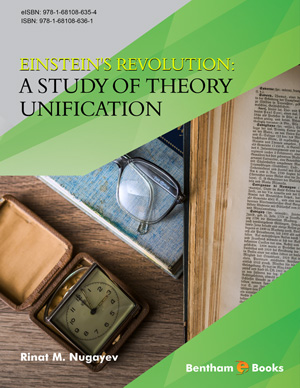Mature Theory Unification and the Objectivity of Scientific Knowledge
Page: 1-47 (47)
Author: Rinat Nugayev
DOI: 10.2174/9781681086354118010003
PDF Price: $15
Abstract
Multifarious arguments pro et contra convergent realism are scrutinized. It is exhibited that to overcome the troubles of convergent realism one has to turn from classical or ‘metaphysical’ realism to non-classical or ‘internal’ one, grounded on Kantian epistemology, and to the so-called ‘coherent theory of truth’. Internal realism has no unassailable problems in grappling with the problem of empirically-equivalent theoretical descriptions and historical meta-induction problem, but obtains the quandary of objectivity of scientific knowledge instead. One of the ways out is proposed by the scientific knowledge growth model elaborated by Rinat Nugayev and by Peter Galison. Any paradigm is a local viewpoint that springs out of the culture into which its creator was submerged. However, an encounter of different paradigms leads to their interaction and intertwinement and, as a result; the crossbred theoretical objects are carefully constructed. Via their systems, the interpenetration of one paradigm into the other one takes place. To elucidate the proposed model of the growth of knowledge, the inter-theoretical context of the Copernican revolution is scrutinized.
Einstein’s 1905 ‘Annus Mirabilis’: Unification of Statistical Mechanics, Maxwellian Electrodynamics and Classical Thermodynamics
Page: 48-144 (97)
Author: Rinat Nugayev
DOI: 10.2174/9781681086354118010004
PDF Price: $15
Abstract
To figure out in what way Einstein’s 1905 ‘annus mirabilis’ (wonder year) writings hang together one has to take into account Einstein’s strive for unity evinced in his vigorous efforts to unify maxwellian electrodynamics, statistical mechanics and classical thermodynamics. It is exposed that Einstein’s ingenious approach to special theory of relativity creation, substantially distinguishing him from Lorentz’s and Poincaré’s impacts, turns out to be a mere milestone of implementation of maxwellian electrodynamics, statistical mechanics and thermodynamics unification programme. Since the ether conception was a substantial snag for Einstein’s statistical thermodynamics design, the leading part in the programme was played by Einstein’s 1905 audacious light quanta hypothesis. Though apparently influenced in his critical stand against the classical physics research tradition by David Hume and Ernst Mach, Einstein hold an overall eclectic philosophical position. Yet when it related to creative momenta, Einstein’s actual 1905 standpoint was closer to Kantian epistemology. It is contended that the most important Kantian concept apt to comprehend the special theory of relativity creation and all Einstein’s 1905 writings as a whole, as well as the order of their arrangement is Kant’s regulative idea of the systematic Unity of Nature. Maxwellian unification of electricity, magnetism and optics as a presentiment of the Einsteinian one is comprehended.
The Contrivance of General Theory of Relativity: Unification of Abraham, Einstein and Nordström’s Hybrid Theoretical Models
Page: 145-189 (45)
Author: Rinat Nugayev
DOI: 10.2174/9781681086354118010005
PDF Price: $15
Abstract
The aim of the chapter is to amend the received view on the general theory of relativity (GTR) genesis and advancement by taking into account common scientific practice of its functioning, the history of science data and certain philosophy of science arguments. The inter-theoretical aspect of the GTR genesis as an instance of perspicuous epistemological model of mature theory change that hinges upon ‘old’ theories encounter and interaction is scrutinized. I strengthen arguments in favour of the tenet that the dynamic creation of GTR had been continually governed by internal tensions between two research traditions, that of special relativity and Newton’s gravity. The encounter of the traditions, their interpenetration and intertwinement engendered the rival programmes of relativistic theory of gravity construction: the programmes of Abraham and Nordstrӧm – on the one hand – and Einstein’s programme – on the other. The encounter created the hybrid realm at first with an irregular set of theoretical models. The rival approaches of Einstein, Abraham and Nordström grew closer and eventually were transformed by Einstein into complementary ‘mathematical’ and ‘physical’ strategies of a general synthetic research programme that put forward the Entwurf and the GTR. Step by step, on eliminating the contradictions between the models contrived, the hybrid set was put into order by Einstein via the principle of equivalence. As in the STR case, Einstein was able to freely juxtapose Nordstrӧm, Abraham’s and his own non-metric theoretical schemes without reducing one to the others. It is contended that the main reason for the GTR ‘victory’ over the rival programmes of Abraham and Nordström was a synthetic character of Einstein’s programme. Einstein’s programme did supersede the rival ones because it did ingeniously assimilate some ideas of the Nordström programme as well as some presuppositions of the programme of Abraham. Einstein had put forward as a basic synthetic principle the principle of equivalence that radically differed from that of rival approaches by its open, flexible and regulative character. As a result of reconciling and amalgamating the ‘physical’ and ‘mathematical’ approaches, embodied in Abraham, Einstein and Nordström’s crossbred theoretical models , Einstein was able to explain the anomalous motion of Mercury.
Introduction
Einstein’s Revolution: A Study of Theory Unification gives students of physics and philosophy, and general readers, an epistemological insight into the genesis of Einstein’s special relativity and its further unification with other theories. The book starts with an introductory analysis of the reasons for mature theory change in science. This leads to a discussion about special relativity genesis. It is contended that Einstein’s ingenious approach to special relativity creation, substantially distinguishing him from Lorentz’s and Poincaré’s invaluable impacts, turns to be a milestone of maxwellian electrodynamics, statistical mechanics and thermodynamics reconciliation design. Special relativity turns out to be grounded on Einstein’s breakthrough 1905 light quantum hypothesis. Eventually the author amends the received view on the general relativity genesis by stressing that the main reason for Einstein’s victory over the rival programmes of Abraham and Nordström was a unificationist character of Einstein’s research programme.













